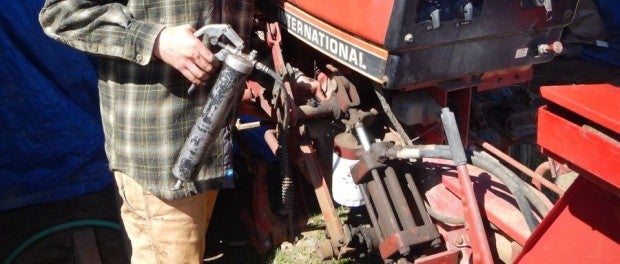Got a Farm Tractor? Give it Grease!

The tractor is one of the most useful machines you can have around the farm. Whether it is an old one or a new one, tractors are able to aid us in much of what we accomplish on a daily basis. These machines do need various types of maintenance to keep them going, however. One thing in particular that must be done in order to keep your tractor in good working order is greasing/lubricating.
Farm tractors have many moving parts and it is necessary that they receive routine grease applications to keep them mobile. Since many of the components on a tractor do not feed into a grease reservoir, that means they must be greased manually. This is particularly important for parts that move rapidly in a constant or frequent state of velocity because movement without grease results in the generation of heat, causing friction and wear. This ultimately can equate to parts wearing out prematurely in the event they are not lubricated, which is where the human intervention part of the equation comes into play.
In order to properly grease your tractor, you first need to know what parts actually need greasing. Since there can be some variation between models, it is wise to consult the owner’s manual for a detailed breakdown. Do note that in some texts you may also find lubrication points referred to as zerks, which is a nickname descending from the man who patented grease fittings, Oscar Zerk. Some of the typical areas in need of grease are:
Ball Joints
Bearings
Clutch Linkages
Master Brake Linkage Shaft and King Pins
Steering Cylinder Ball Joints (left and right)
Steering Components
Three-Point Hitch Pivot Points
Tie Rod Ends (left and right)
The reason behind greasing is to keep moving parts from overheating, but there is more to it than simply adding grease and going on about your day. Dirt and debris are also enemies of moving parts as they, too, can create friction regardless of the presence of grease. To prevent this type of friction, you also need to prevent an accumulation of dirt and debris. Always clean lubrication points before adding grease to avoid forcing dirt and debris into the seal. Additionally, keep your tractor clean; despite the fact that you’re going to take it right back out into the same dirty, dusty field tomorrow, take the time to rinse away any dirt and debris at the end of each day.
When adding lubricant, it is important not to be overzealous. Just like dirt and debris can harm seals, so can too much grease. It is possible to stretch seals if you pump the grease gun excessively to the point that grease begins to seep out. Once seals are stretched, they will not retain an adequate amount of grease and will be susceptible by invasion of dirt and debris as well as thermal breakdown. To avoid this, make it a practice to add less grease more often than to cram a bunch in there all at one time, taking care to always wipe grease points with a rag before and after administering lubricant.
If you have doubts about the parts that need lubrication and at what frequency, the owner’s manual will be useful in providing this information as well as the type of grease to use for your tractor. In some cases greasing will be necessary on a daily basis whereas other times it might be weeks or months as the determination is often based on hours of use. To manage the administering of grease, keep a maintenance journal. This will enable you to track what you greased and when as well as what to grease in the future because the more attention you pay to this seemingly small aspect of farm tractor ownership, the better that machine will serve you in the long run.







 Your Privacy Choices
Your Privacy Choices
Tractors may have replaced some animals in doing farm work but they still need attention too. Greasing is one way of keeping the tractor in shape. Friction in the parts the move will really creep on you if you neglect proper lubrication.